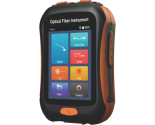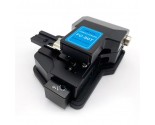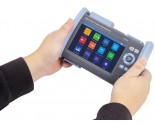The Multimeter is an optical power meter and visual fault locator integrated instrument. It is with a 0.96 inch in size and 128x64 in resolution OLED display. It is powered by a built-in 500mAh rechargeable lithium battery, and its charging port is a Type C interface that complies with the Type C standard. The design is compact and convenient, with a total weight of 50g. It comes with 1000 data stores and supports user viewing and user self calibration. It also supports data export and calibration by PC computer that comes togetherwith the device. The mW value and dBm value are displayed simultaneously, facilitating the needs of difffferent users. The output power of the red light source is optional: 5mW/10mW/20mW/30mW/50mW.
Features
- Thumb sized, extremely small
- OLED display, visible from any angle, even under strong sun light
- Rechargeable lithium battery
- Type-C USB for battery charging & Data Transmission
- User self calibration suported
- Up to 1000 data storage memory
- Come with PC software, data can be exported to computer
- User setting memorized (WL, unit)
- Frequency Detection Supported
- Display mW & dBm simultaneously
- VFL Output power extremely stable from beginning to battery exhausted
|
Optical Power Meter (OPM)
|
|
|
Working Range
|
-70 to +10dBm/-50 to +26dBm
|
|
Wavelength Range
|
800nm to 1700nm
|
|
Connector
|
2.5mm Universal
|
| Photodetector |
InGaAs
|
|
Uncertainty
|
5%
|
|
Calibrated Wavelength
|
850/1300/1310/1490/1550/1625/1650nm
|
|
Display Resolution
|
1%, 0.01dBm
|
|
Frequency Identifification
|
CW/270Hz/330Hz/1kHz/2kHz
|
|
Data Storage
|
1000 (wavelength, power value, frequency, unit)
|
|
Calibration method
|
1. by functional buttons combination
2. by PC software
|
|
Visual Fault Locator (VFL)
|
|
|
Working wavlength
|
650nm±30nm
|
|
Output power
|
2mW/5mW/10mW/20mW/30mW/50mW
|
|
Mode
|
CW/2Hz
|
|
Connector
|
2.5mm Universal
|
| General | |
|
Display
|
OLED
|
|
Resolution
|
128x64
|
|
Battery
|
3.7v/500mAh
|
|
Charging port
|
Type C USB
|
|
Auto off
|
10 mins
|
|
Working Temperature
|
-10 to +50 oC
|
|
Storage Temperature
|
-10 to +60 oC
|
|
relative humidity (RH)
|
0 to 95%
|
|
Size
|
98x33x23mm
|
|
Weight
|
50g
|
You may also be interested in the following product(s)
Warranty Service:
FirstFiber warrants to the purchaser that our products shall be free from defects in material and workmanship under normal use (consumables, normal tear and wear excluded) for a period of one year from the date of shipment. Any part which is determined by FirstFiber to be defective in material or workmanship shall be returned to FirstFiber or authorized service location, as FirstFiber designates and shipping costs prepaid. Defective items will be repaired or replaced at FirstFiber's option.
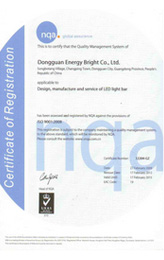 |
ISO9001:2008 The certificate shows that a component/subsystem can be used in a specific application according to a requirement class (RC) or a integrity level (SIL). The system integrator and end user must always be aware of how to use certified components/subsystems in safety-related function, respectively a safety instrumented system. Because of the many different possibilities and how to configure a safety system, the end user must get the related information from the manufacturer of the certified component/subsystem. |
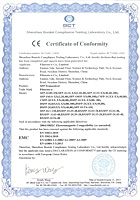 |
CE The CE marking is a mandatory European marking for certain product groups to indicate conformity with the essential health and safety requirements set out in European. To permit the use of a CE mark on a product, proof that the item meets the relevant requirements must be documented. |
|
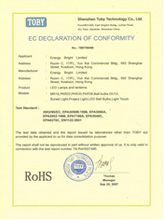 |
RoHS Working in partnership with the policy lead at BERR (The Department for Business, Enterprise & Regulatory Reform), NWML is the UK Enforcement Authority for the Restriction of the Use of Certain Hazardous Substances in Electrical and Electronic Equipment Regulations 2008 (the “RoHS Regulations”). Manufacturers need to understand the requirements of the RoHS Directive to ensure that their products, and their components, comply. |
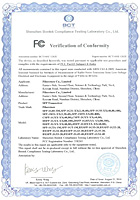 |
FCC The Federal Communications Commission (FCC) is an independent United States government agency. The FCC was established by the Communications Act of 1934 and is charged with regulating interstate and international communications by radio, television, wire, satellite and cable. The FCC's jurisdiction covers the 50 states, the District of Columbia, and U.S. possessions. |


